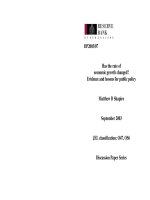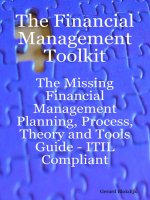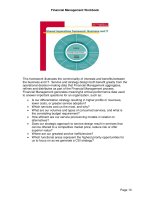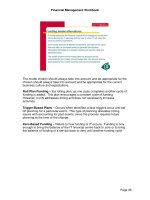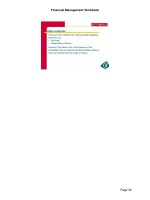The Financial Management Toolkit The Missing Financial Management Planning Process Theory and Tools Guide ITIL Compliant_8 pdf
Bạn đang xem bản rút gọn của tài liệu. Xem và tải ngay bản đầy đủ của tài liệu tại đây (86.83 KB, 13 trang )
Financial Management Workbook
Page 91
Key Performance Indicators (KPI’s)
Continuous improvement requires that each
process needs to have a plan
about “how” and “when” to measure its own performance. While there can be
no set guidelines presented for the timing/when of these reviews; the “how”
question can be answered with metrics and measurements.
With regard to timing of reviews then factors such as resource availability,
cost and “nuisance factor” need to be accounted for. Many initiatives begin
with good intentions to do regular reviews, but these fall away very rapidly.
This is why the process owner must have the conviction to follow through on
assessments and meetings and reviews, etc. If the process manager feels
that reviews are too seldom or too often then the schedule should be changed
to reflect that.
Establishing SMART targets is a key part of good process management.
SMART is an acronym for:
Simple
Measurable
Achievable
Realistic
Time Driven
Metrics help to ensure that the process in question is running effectively.
Financial Management Workbook
Page 92
With regard to FINANCIAL MANAGEMENT the following metrics and
associated targets should be considered:
Key Performance Indicator Target Value
(some
examples)
Time
Frame/Notes/Who
Using data from the Configuration
Management Database (CMDB) indicate any
particular Configuration items that are going
through continual change.
For Financial Management the KPI’s are
broken into three specific groups as indicated.
Effective stewardship of the IT finances:
• Increased accuracy of cost recovery
profiles and expenditure.
• The IT organization is operated within
the expected income/level of profits.
• The IT financial objective of either
break-even or profit (whichever is the
objective of the enterprise) is met.
• Increased accuracy of monthly,
quarterly and annual forecasted
profiles.
• Reduced frequency and severity of
Changes required to the Accounting
and Budgeting systems.
• All IT costs are accounted for.
• Reduced frequency and severity of
Changes made to the Charging
algorithms (where appropriate).
• Timely production of budget forecasts
and reports.
• Timely production of the Financial
Plan, IT accounts and reports.
Overall effectiveness of the process:
• Plans and budgets produced on time.
• Specified reports produced at the
required time.
• The inventory schedules are kept up-
to-date.
• Timeliness of annual audits.
• Meeting of monthly, quarterly and
annual financial objectives.
• Reduction in the relative costs.
• Reduction in the number of budget
variances and adjustments.
Financial Management Workbook
Page 93
• Reduction in the variances from the
Financial Plan.
• Relative reduction in the overall Total
Cost of Ownership (TCO).
Customers satisfied with cost of provision:
• Charges, where applied, are seen to
be fair.
• Reduction in the number queries and
complaints from Customers relating to
the calculation of IT costs and
charges.
Others
Special Tip: Beware of using percentages in too many cases. It may even be
better to use absolute values when the potential number of maximum failures
is less than 100.
Financial Management Workbook
Page 94
Reports for Management
Management reports help identify future trends and allow review of the
“health” of the process. Setting a security level on certain reports may be
appropriate as may be categorizing the report as Strategic, Operational or
Tactical.
The acid test for a relevant report is to have a sound answer to the question;
“What decisions is this report helping management to make?”
Management reports for Financial Management should include:
Report Time Frame/Notes/Who
How much they have spent on IT during the financial year.
Whether the charges made match the predicted profile.
The current Charging policies and IT Accounting methods.
How the IT organization is investing any profits (e.g. in
Infrastructure or service improvements).
Any variances, what caused them and what actions are being
taken.
Cost total, broken down by business.
Cost analyses by service line, equipment domain or other relevant
view.
Revenues total, broken down by business.
Costs and cost recovery against profile.
Outlook on costs and cost recovery.
Problems and costs associated with IT Accounting and Charging
systems.
Financial Management Workbook
Page 95
Recommendations for changes.
Future investments required.
Financial Management Workbook
Page 96
Financial Management Workbook
Page 97
3.10 Sample Business Case Structure
A. Introduction
Presents the business objectives addressed by the service.
B. Methods and assumptions
Defines the boundaries of the business case, e.g. time period, whose
costs, whose benefits.
C. Business Impacts
The financial and non-financial business case results.
D. Risks and contingencies
The probability that alternatives results will emerge.
E. Recommendations
Specific actions recommended.
Financial Management Workbook
Page 98
Financial Management Workbook
Page 99
3.11 Common Business Objectives
OPERATIONAL FINANCIAL STRATEGIC INDUSTRY
Shorten
development time
Improve return on
assets
Establish or enhance
strategic positioning
Increase
market share.
Increase
productivity
Avoid costs
Introduce competitive
results
Improve
market
position
Increase capacity
Increase
discretionary
spending as a
percentage of
budget
Introduce competitive
products
Increase
repeat
business
Increase reliability
Decrease non-
discretionary
spending
Improve
professionalism of
organization
Take market
leadership
Minimize risks
Increase revenues
Provide better quality
Recognized as
producer of
reliable or
quality
products
and/or
services
Improve resource
utilization
Increase margins
Provide customized
offerings
Recognized as
low price
leader
Improve
efficiencies
Keep spending to
within budget
Introduce new
products or services
Recognized as
complaint to
industry
standards.
Financial Management Workbook
Page 100
Financial Management Workbook
Page 101
3.12 Example – Single Business Impact can affect Multiple Business
Objectives
Business Impact
Tangible Measure:
MTTR (Mean Time to Repair)
Impact:
MTTR to 2 hours from 6 hours
Business Objectives
Tangible Measure:
Service Delivery Costs
Target: Lower SD costs by 30%
MTRS
Tangible Measure:
Repeat Rate of Business Target:
Improve rate to 60% from 25%
Tangible Measure:
Customer quality surveys
Target: Improved industry ranking to
1
st
from 3
rd
Lower Costs
Customer
Satisfaction
Market Image
Improved
Maintainability
Financial Management Workbook
Page 102
Financial Management Workbook
Page 103
3.13 Example – Multiple Business Impact can affect Single Business
Objectives
Business Impact
Tangible Measure:
MTBF (Mean Time Between Failure)
Impact:
MTBF to 200 hours from 600 hours
Tangible Measure:
MTTR (Mean Time to Restore)
Impact:
MTTR to 2 hours from 6 hours
Tangible Measure:
Product orders can now be placed
on-line
Impact:
Product orders can be placed 24x7
Business Objectives
Tangible Measure:
Repeat Rate of Business
Target:
Improve rate to 60% from 25%
Customer
Satisfaction
Improved
Reliability
Improved
Maintainability
Improved
Services





